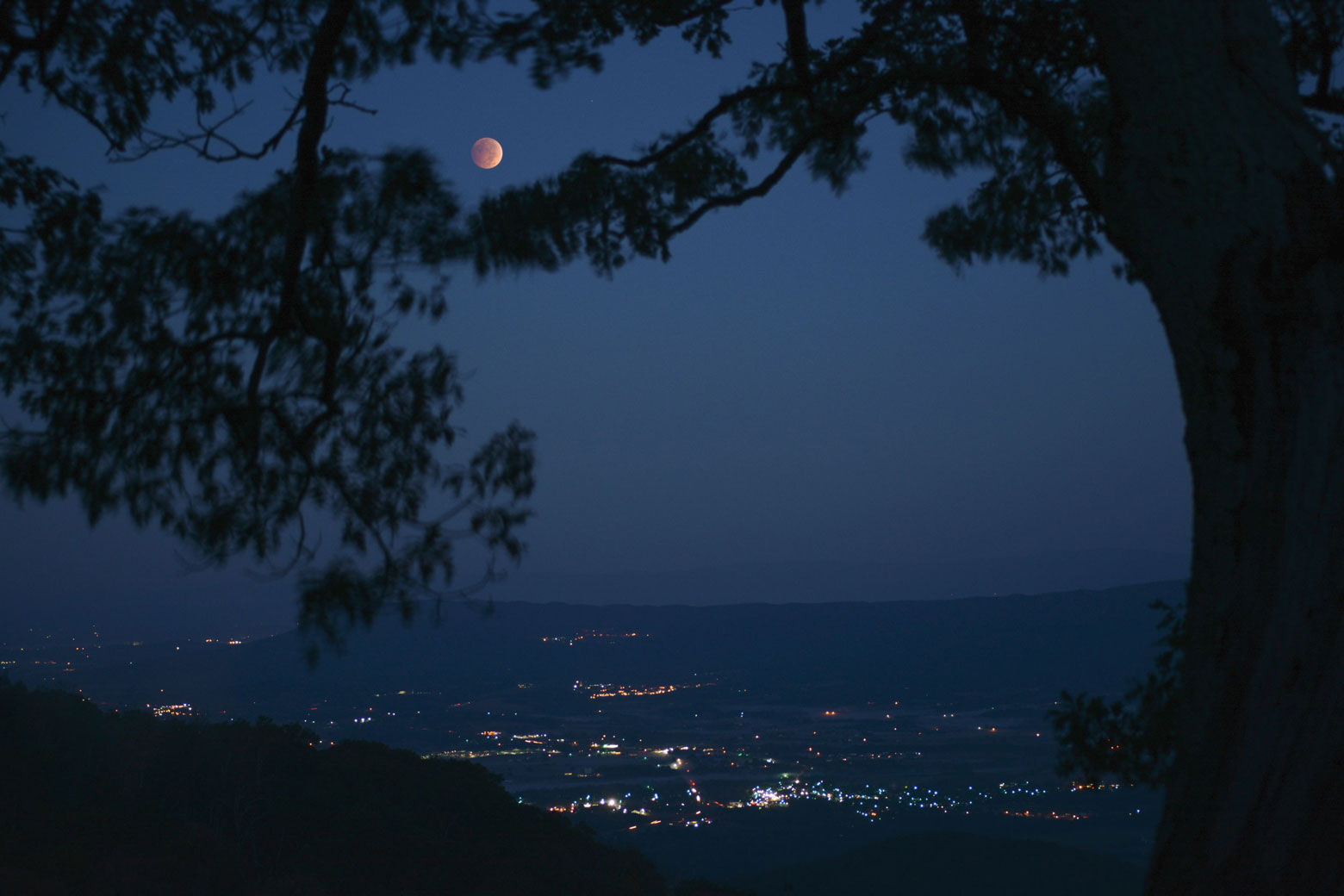Stay in Touch
Get sneak previews of special offers & upcoming events delivered to your inbox.
Sign in
11-07-2022 10:38 PM
[Posted on WTOP online]
Greg Redfern -- skyguyinva@gmail.com
November 7, 2022, 1:27 PM

Shenandoah National Park, where this photo was taken, would be an excellent spot to see the lunar eclipse. (Courtesy Greg Redfern)
On Tuesday, half of the planet, including the DMV [District, Maryland and Virginia], will be treated to a total lunar eclipse of the Full Beaver Moon. And according to EarthSky.org, this will be the first Election Day total lunar eclipse in U.S. history — and it won’t happen again until Nov. 8, 2394.
It is also the last total lunar eclipse until 2025, so you want to make an effort to see this one!
The good news is, the weather should be mostly clear in the DMV during the eclipse. The bad news is that in the D.C. area, the moon will be deepest in the Earth’s shadow just before sunrise, which means brightening skies – also, the totally eclipsed moon will be very low in the sky as it sets in the west.
Edward Murphy, a professor of astronomy at the University of Virginia, said in an email that the partial phases will begin at 4:09 a.m., when the moon enters the darkest part of the Earth’s shadow, called the umbra.
“At this time, the full moon will be low in the western sky and easy to see, weather permitting,” he said. “The moon will gradually disappear as it slides into the umbra over the next 66 minutes.”
At 5:17 a.m., the moon will be completely inside the Earth’s umbra, and will look deep red or coppery, “because the light illuminating the moon is the light from all of the world’s sunrises and sunsets,” Murphy said.
At around 6 a.m., the moon will be at its faintest and reddest, Murphy said, but then the skies will brighten and the moon will be low.
“Totality ends at 6:42 a.m., and the moon sets and the sun rises just a few minutes later!” he said.
I have seen lunar eclipses under these conditions before, and it is difficult to see totality as the sky brightens. The best locations to see it are places where the western horizon is clear of trees and buildings. The west- and northwest-facing turnouts of Shenandoah National Park would be excellent. They provide a decent horizon and elevation for a good view of the setting/partially eclipsed moon. Be sure to check the park’s website for any updates first.
Binoculars will help immensely and are highly recommended — mandatory, really — to try to see totality as the sky brightens.
You may see references to this total lunar eclipse as a "Blood Moon." It is a phrase used to describe the reddish color the moon takes on, caused by sunlight passing through the Earth’s atmosphere and falling on the surface of the moon. Because our planet is totally blocking out the light of the sun, this reddish color — just like we can see at sunrise/sunset here on Earth — is the only light reaching the moon. The DMV will see some of that phase.
[The part of me that wonders about mystical forces and their possible effect on everyday events is already working overtime to figure out the effect this lunar eclipse might have on the election results. Fingers crossed, nothing bizarre takes place, and the eclipse is just an eclipse.]
11-07-2022 10:44 PM
Thank you! I'll go out and look now.
This reminds me of the lady who posted the pictures of sunsets. Her name also started with a g. I haven't seen her recently.
11-07-2022 10:44 PM - edited 11-07-2022 10:46 PM
@golding76 Thank you for posting this fascinating information.
And, from your mouth to the Heavens hearing, let us hope that the fact that this is happening for the first time on our election day will not bring any "lunacy" with it.
aroc3435
Washington, DC
11-07-2022 10:48 PM - edited 11-07-2022 10:51 PM
on the bay, it is too early to go out now.
The photo was taken by Mr. Redfern during another eclipse. BUT YOU ARE SO RIGHT! The photo looks like the work of Godi, who did such beautiful photography. I miss her scenic work. She has a gift.
The partial eclipse will begin at 4:09 a.m. And then it will progress to a total eclipse.
11-07-2022 10:59 PM
While looking for her posts, I saw this one of Godi's-one of my favorites of hers!
11-07-2022 11:21 PM
@on the bay wrote:While looking for her posts, I saw this one of Godi's-one of my favorites of hers!
Some mythers believe that the eclipse was caused by the Devil swallowing the moon and if they threw stones at it and cursed it, they could chase it away.
Get sneak previews of special offers & upcoming events delivered to your inbox.
*You're signing up to receive QVC promotional email.
Find recent orders, do a return or exchange, create a Wish List & more.
Privacy StatementGeneral Terms of Use
QVC is not responsible for the availability, content, security, policies, or practices of the above referenced third-party linked sites nor liable for statements, claims, opinions, or representations contained therein. QVC's Privacy Statement does not apply to these third-party web sites.
© 1995-2025 QVC, Inc. All rights reserved. | QVC, Q and the Q logo are registered service marks of ER Marks, Inc. 888-345-5788